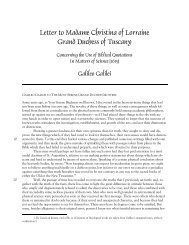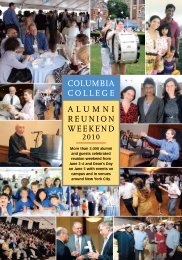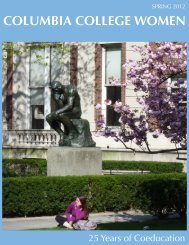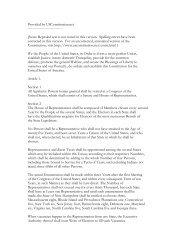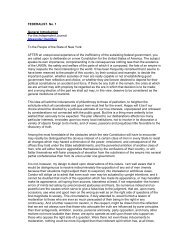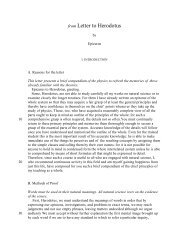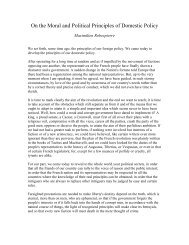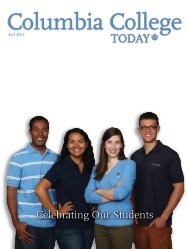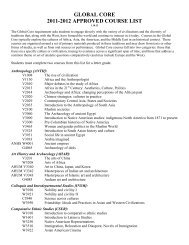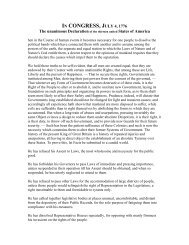Download this issue as a PDF - Columbia College - Columbia ...
Download this issue as a PDF - Columbia College - Columbia ...
Download this issue as a PDF - Columbia College - Columbia ...
Create successful ePaper yourself
Turn your PDF publications into a flip-book with our unique Google optimized e-Paper software.
AROUND THE QUADS<br />
COLUMBIA COLLEGE TODAY<br />
COLUMBIA COLLEGE TODAY<br />
AROUND THE QUADS<br />
With the goal of one day<br />
shedding light on some<br />
grand questions —<br />
“Why is the universe<br />
expanding What is the 96 percent of<br />
matter and energy we can’t see right<br />
now” — Bryan Terraz<strong>as</strong> ’13 h<strong>as</strong> taken<br />
an ambitious approach to his undergraduate<br />
work in <strong>as</strong>trophysics.<br />
Terraz<strong>as</strong>, a John Jay Scholar, spent<br />
summer 2011 at the renowned European<br />
Organization for Nuclear Research<br />
(CERN) in Geneva, Switzerland, which<br />
aims to understand the workings of the<br />
universe through particle physics. Funded<br />
by a <strong>Columbia</strong> Undergraduate Scholars<br />
Program Summer Enhancement Fellowship,<br />
Terraz<strong>as</strong> plotted data resulting<br />
from the incredibly high-energy proton<br />
collisions within the Large Hadron Collider,<br />
the world’s most powerful particle<br />
accelerator. He then compared the results<br />
against how current theories state<br />
subatomic particles should interact. The<br />
aim: to find discrepancies that would<br />
signal the existence of previously undetected<br />
particles or forces.<br />
Terraz<strong>as</strong>, who stayed in an apartment<br />
in the town of Saint-Genis-Pouilly in<br />
France and rode a bike across the border<br />
daily to CERN’s facilities, relishes having<br />
been part of that groundbreaking experiment,<br />
known <strong>as</strong> ATLAS. “It w<strong>as</strong> amazing<br />
to feel the need, the urgency, the<br />
drive throughout everything that<br />
I w<strong>as</strong> doing at CERN,” he says.<br />
At CERN, Terraz<strong>as</strong> also realized<br />
that he prefers <strong>as</strong>tronomy<br />
to pure physics. And so, l<strong>as</strong>t<br />
summer, he spent two months at<br />
the Harvard-Smithsonian Center<br />
for Astrophysics in Cambridge,<br />
M<strong>as</strong>s., where he created computerized<br />
models to simulate the<br />
evolution of radio lobes — perpendicular<br />
plumes of matter that<br />
rise from black holes at the center<br />
of galaxies and are believed to<br />
heat the atmospheres around<br />
them. The project w<strong>as</strong> funded<br />
by the National Science Foundation’s<br />
Research Experiences for<br />
Undergraduates program, which<br />
STUDENT SPOTLIGHT<br />
Bryan Terraz<strong>as</strong> ’13 Pursues F<strong>as</strong>cination with the Cosmos<br />
B y Nat h a l i e A l o n s o ’08<br />
covered Terraz<strong>as</strong>’ expenses. “It w<strong>as</strong> a<br />
very difficult project,” Terraz<strong>as</strong> says.<br />
“My adviser, <strong>as</strong>tronomer Paul Nulsen,<br />
w<strong>as</strong> amazing. He gave me a lot of<br />
tough things to do, which I had worked<br />
with before, but not to that extent.”<br />
Just prior to leaving for Cambridge,<br />
Terraz<strong>as</strong> spent a week living at the MDM<br />
Observatory on Kitt Peak in Arizona,<br />
which is partly owned and operated by<br />
<strong>Columbia</strong>. He slept by day and spent<br />
nights learning how to use telescopes<br />
to observe changes in the brightness of<br />
cataclysmic variables — binary stars in<br />
which a dense white dwarf star tears<br />
matter from a normal star. Cataclysmic<br />
variables, Terraz<strong>as</strong> explains, allow<br />
<strong>as</strong>tronomers to study the relationships<br />
between different types of stars.<br />
Through his undergraduate work,<br />
Terraz<strong>as</strong> h<strong>as</strong> narrowed his interests to<br />
extragalactic <strong>as</strong>tronomy, which studies<br />
phenomena outside the Milky<br />
Way Galaxy. For his senior thesis, he<br />
is working with Associate Professor<br />
of Astronomy Greg Bryan to update<br />
models of how the universe’s first stars<br />
came into being. “As Bryan learns,<br />
he is clearly trying to put all of <strong>this</strong><br />
information into some sort of coherent<br />
structure; he’s trying to piece together a<br />
big picture,” says Bryan. “Like the best<br />
scientists, he is forming models in his<br />
Bryan Terraz<strong>as</strong> ’13, shown here at the Rutherford Observatory<br />
atop Pupin Hall, h<strong>as</strong> spent his undergraduate years<br />
sampling various <strong>as</strong>pects of <strong>as</strong>trophysics.<br />
PHOTO: KRISTEN STRYKER<br />
head and using these models to make<br />
predictions about new situations.”<br />
Born in Los Angeles to Bolivian<br />
immigrants, Terraz<strong>as</strong> w<strong>as</strong> 3 when his<br />
family moved to northern Virginia.<br />
He traces his love of <strong>as</strong>tronomy to a<br />
fourth-grade field trip to the local planetarium,<br />
and now tries to instill that<br />
same sense of awe in others. One night<br />
a month, through the Harlem Sidewalk<br />
Astronomy project, Terraz<strong>as</strong> and fellow<br />
students from the <strong>as</strong>trophysics department<br />
set up telescopes in Federal Plaza<br />
in Harlem and invite p<strong>as</strong>sersby to take<br />
a look at planets and other celestial<br />
bodies. “It’s not like they are going to<br />
an event where they are expecting to<br />
learn about science. I have to be able<br />
to engage them just like that,” Terraz<strong>as</strong><br />
says. “It’s interesting to try to explain<br />
the concept <strong>as</strong> well <strong>as</strong> create wonder<br />
and get them enthralled with the subject.<br />
It’s a challenge, but it’s really fun.”<br />
Given his scientific bent, few would<br />
guess that Terraz<strong>as</strong> also is an accomplished<br />
clarinetist. He began playing<br />
at 10 and, through <strong>Columbia</strong>’s music<br />
department, takes private lessons at<br />
The Metropolitan Opera. He also performs<br />
with the <strong>Columbia</strong> University<br />
Orchestra.<br />
At press time, Terraz<strong>as</strong> w<strong>as</strong> awaiting<br />
responses from several research fellowships<br />
and graduate programs. As<br />
he considers his next move, he<br />
finds himself motivated not by<br />
what he h<strong>as</strong> learned thus far but<br />
by the many questions in his field<br />
that remain unanswered.<br />
“It’s really not about being<br />
perfect at calculating what is<br />
already known,” Terraz<strong>as</strong> says.<br />
“It’s about pushing the boundaries<br />
of what you know. That’s really<br />
what research h<strong>as</strong> taught me.<br />
Every single project that I’ve been<br />
a part of h<strong>as</strong> incorporated <strong>this</strong>.”<br />
Nathalie Alonso ’08, from Queens,<br />
is a freelance journalist and an editorial<br />
producer for L<strong>as</strong>Mayores.com,<br />
Major League B<strong>as</strong>eball’s official<br />
Spanish language website.<br />
IN MEMORIAM<br />
n Karl-Ludwig Selig, professor emeritus<br />
of Spanish and Portuguese and a Cervantes<br />
scholar, died on December 1, 2012,<br />
on the Upper West Side. He w<strong>as</strong> 86.<br />
Selig is regarded <strong>as</strong> one of the world’s<br />
foremost experts on Cervantes’ Don Quixote.<br />
Known for his course “The Novella:<br />
from Boccaccio to Cervantes,” Selig p<strong>as</strong>sionately<br />
made the c<strong>as</strong>e that the modern<br />
novel is dependent on Cervantes’ picaresque<br />
work. He also taught “M<strong>as</strong>terpieces<br />
of Western Literature and Philosophy<br />
II,” also known <strong>as</strong> “Super Lit Hum.”<br />
Those who took Selig’s cl<strong>as</strong>s “could<br />
never get the books, or the professor, out<br />
of [their] mind. Fifty years later, people<br />
can recite his lectures,” said Christopher<br />
Allegaert ’78 in a recent Spectator article.<br />
Selig w<strong>as</strong> born into a Jewish family in<br />
Wiesbaden, Germany, in 1926. He and his<br />
parents fled to the United Kingdom in<br />
1939, before the start of WWII, relocating<br />
to Erie, Pa. Selig earned a B.A. from Ohio<br />
State, where he also swam; an M.A. from<br />
Ohio State; and a Ph.D. from the University<br />
of Tex<strong>as</strong>, where he later taught. He received<br />
his United States citizenship in 1948<br />
and taught at the University of Minnesota,<br />
Johns Hopkins, North Carolina and Cornell<br />
before joining <strong>Columbia</strong> in 1966. Selig<br />
w<strong>as</strong> presented <strong>Columbia</strong>’s Mark Van<br />
Doren Award for Teaching in 1974. After<br />
leaving <strong>Columbia</strong> in 1989, he taught at the<br />
University of the South (Sewanee) and at<br />
the University of Greifswald, Germany.<br />
Selig wrote or co-authored 45 books,<br />
many of which have been translated into<br />
multiple languages.<br />
Selig always w<strong>as</strong> willing and excited to<br />
speak with his students, and dozens attended<br />
his 86th birthday celebration l<strong>as</strong>t August.<br />
Harper’s Magazine Publisher John Mac-<br />
Arthur ’78 referenced Selig l<strong>as</strong>t year in<br />
his Cl<strong>as</strong>s Day address: “He wanted you<br />
Have You Moved<br />
To ensure that you receive<br />
CCT and other <strong>College</strong><br />
information, let us know if<br />
you have a new postal or<br />
email address, a new phone<br />
number or even a new name.<br />
Click “Contact Us” at<br />
college.columbia.edu/cct<br />
or call 212-851-7852.<br />
PHOTO: LORI GRINKER/<br />
CONTACT PRESS IMAGES<br />
to embrace the text, to read it<br />
with rigor, but also with ple<strong>as</strong>ure.<br />
However, like all of my<br />
best professors, Selig insisted<br />
that reading text w<strong>as</strong> a fundamentally<br />
serious endeavor,<br />
that text must be respected.”<br />
“He w<strong>as</strong> resolved to fight<br />
<strong>as</strong> only a devotee of Don Quixote<br />
could,” said another former<br />
student, Dennis Klainberg<br />
’84, “by staying optimistic,<br />
fighting to live another day<br />
and keeping in close touch<br />
with all his friends, colleagues and especially,<br />
his beloved students.”<br />
Selig had an appreciation for the rowing<br />
team, which named two<br />
sculls after him. A remembrance<br />
will be held for him<br />
<strong>this</strong> spring at the <strong>Columbia</strong><br />
Cl<strong>as</strong>s of 1929 Boathouse.<br />
Karl Daum ’15<br />
Former students may share<br />
memories of Selig on the “Fans<br />
of Karl-Ludwig Selig” group<br />
on Facebook. Several of Selig’s<br />
former students have taken up<br />
a collection for his caretaker,<br />
Gilbert Adiaba. For information<br />
on how to donate, contact Dennis Klainberg<br />
’84 (dennis@berklay.com) or Ted Allegaert ’87<br />
(tallegaert@hotmail.com).<br />
Dean’s Scholarship Reception 2013<br />
Nearly 500 named scholarship donors<br />
and student recipients filled Roone<br />
Arledge Auditorium on February 7 at<br />
the annual Dean’s Scholarship Reception.<br />
Each year, nearly 1,200 <strong>Columbia</strong> <strong>College</strong><br />
students receive named<br />
scholarships <strong>as</strong> part<br />
of their financial aid<br />
package, and <strong>this</strong> event<br />
allows the students and<br />
donors to meet one<br />
another and share their<br />
<strong>College</strong> experiences.<br />
Dean James J. Valentini<br />
welcomed attendees,<br />
saying, “We have, by<br />
all me<strong>as</strong>ures, the most<br />
diverse college among<br />
selective schools in the<br />
country. Financial aid is a tool that allows us<br />
to create the <strong>Columbia</strong> that we have.”<br />
The evening’s donor speaker, James T.<br />
Brett ’84, ’90 Business, echoed the sentiment:<br />
“We are all here today because we<br />
The reception allows scholarship<br />
recipients and their donors to meet.<br />
PHOTO: CHRIS BALMER ’07<br />
are invested in the future of <strong>Columbia</strong> <strong>College</strong>,”<br />
he said. “We want to remain competitive,<br />
and named scholarships allow us to<br />
do so.”<br />
Brandon Lewis ’13 spoke on behalf of the<br />
scholarship recipients.<br />
“What can I possibly<br />
say to thank you for <strong>this</strong><br />
opportunity” he said,<br />
addressing the donors<br />
in the room. “The day<br />
I received my letter of<br />
acceptance w<strong>as</strong> a happy<br />
one but I w<strong>as</strong>n’t truly<br />
elated until I received<br />
the financial aid package<br />
that allowed it to<br />
become a reality.”<br />
To view a video from the reception <strong>as</strong> well<br />
<strong>as</strong> the 2012–13 Scholarship Directory, go to<br />
college.columbia.edu/cct. To view photos<br />
from the reception, go to facebook.com/<br />
<strong>Columbia</strong><strong>College</strong>1754/photos_albums.<br />
DATE SMART!<br />
Join the singles’<br />
network exclusively<br />
for graduates, faculty<br />
and students of the<br />
Ivy League<br />
MIT, Stanford and<br />
few others.<br />
www.rightstuffdating.com<br />
1-800-988-5288<br />
SPRING 2013<br />
14<br />
SPRING 2013<br />
15




